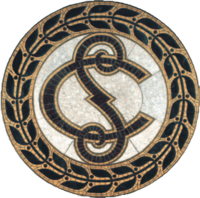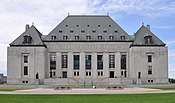Supreme Court of Canada
The Supreme Court of Canada (French: Cour suprême du Canada) is the highest court of Canada, the final court of appeals in the Canadian justice system.[1] The court grants permission to between 40 and 75 litigants each year to appeal decisions rendered by provincial, territorial and federal appellate courts. Its decisions are the ultimate expression and application of Canadian law and binding upon all lower courts of Canada, except to the extent that they are overridden or otherwise made ineffective by an Act of Parliament or the Act of a provincial legislative assembly pursuant to section 33 of the Canadian Charter of Rights and Freedoms (the "notwithstanding clause").
History
The creation of the Supreme Court of Canada was provided for by the British North America Act, 1867, renamed in 1982 the Constitution Act, 1867. The first bills for the creation of a federal supreme court, introduced in the Parliament of Canada in 1869 and in 1870, were withdrawn. It was not until 8 April 1875 that a bill was finally passed providing for the creation of a Supreme Court of Canada.
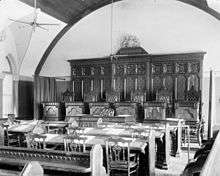
However, prior to 1949, the Supreme Court did not constitute the court of last resort: litigants could appeal to the Judicial Committee of the Privy Council in London. As well, some cases could bypass the court and go directly to the Judicial Committee from the provincial courts of appeal.
The Supreme Court of Canada formally became the court of last resort for criminal appeals in 1933 and for all other appeals in 1949. The last decisions of the Judicial Committee on cases from Canada were made in the mid-1950s, as a result of their being heard in a court of first instance prior to 1949.
The increase in the importance of the Court was mirrored by the numbers of its members. The Court was established first with six judges, and these were augmented by an additional member in 1927. In 1949, the bench reached its current composition of nine justices.
Prior to 1949, most of the appointees to the Court owed their position to political patronage. Each judge had strong ties to the party in power at the time of their appointment. In 1973, the appointment of a constitutional law professor Bora Laskin as chief justice represented a major turning point for the Court. Increasingly in this period, appointees either came from academic backgrounds or were well-respected practitioners with several years experience in appellate courts. Laskin's federalist and liberal views were shared by Prime Minister Pierre Trudeau, who recommended Laskin's appointment to the Court.
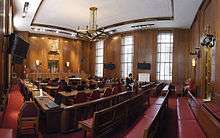
The Constitution Act, 1982, greatly expanded the role of the Court in Canadian society by the addition of the Canadian Charter of Rights and Freedoms, which greatly broadened the scope of judicial review. The evolution from the Dickson court (1984–90) through to the Lamer court (1990–2000) witnessed a continuing vigour in the protection of civil liberties. Lamer's criminal law background proved an influence on the number of criminal cases heard by the Court during his time as chief justice. Nonetheless, the Lamer court was more conservative with Charter rights, with only about a 1% success rate for Charter claimants.
The appointment of Beverly McLachlin as chief justice in 2000 resulted in a more centrist and unified Court. Dissenting and concurring opinions were fewer than during the Dickson and Lamer Courts. With the 2005 appointments of Justices Louise Charron and Rosalie Abella, the court became the world's most gender-balanced national high court, four of its nine members being female.[2][3] Justice Marie Deschamps' retirement on 7 August 2012 caused the number to fall to three,[4] however the appointment of Suzanne Côté on 1 December 2014 restored the number to four.
Canadian judiciary
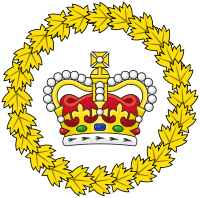 |
|---|
| This article is part of a series on the politics and government of Canada |
| Government |
|
|
|
The structure of the Canadian court system is pyramidal, a broad base being formed by the various provincial and territorial courts whose judges are appointed by the provincial or territorial governments. At the next level are the provinces' and territories' superior courts, where judges are appointed by the federal government. Judgments from the superior courts may be appealed to a still higher level, the provincial or territorial courts of appeal.
Several federal courts also exist: the Tax Court of Canada, the Federal Court, the Federal Court of Appeal, and the Court Martial Appeal Court of Canada. Unlike the provincial superior courts, which exercise inherent or general jurisdiction, the federal courts' jurisdiction is limited by statute. In all, there are over 1,000 federally appointed judges at various levels across Canada.
Appellate process
The Supreme Court of Canada rests at the apex of the judicial pyramid. This institution hears appeals from the provincial courts of last resort, usually the provincial or territorial courts of appeal, and the Federal Court of Appeal, although in some matters appeals come straight from the trial courts, as in the case of publication bans and other orders that are otherwise not appealable.
In most cases, permission to appeal must first be obtained from the court. Motions for leave to appeal to the Court are generally heard by a panel of three judges of the Court and a simple majority is determinative. By convention, this panel never explains why it grants or refuses leave in any particular case, but the Court typically hears cases of national importance or where the case allows the Court to settle an important issue of law. Leave is rarely granted, meaning that for most litigants, provincial courts of appeal are courts of last resort. But leave to appeal is not required for some cases, primarily criminal cases (in which a Judge below dissented on a point of law) and appeals from provincial references.
A final source of cases is the referral power of the federal government. In such cases, the Supreme Court is required to give an opinion on questions referred to it by the Governor-in-Council (the Cabinet). However, in many cases, including the most recent same-sex marriage reference, the Court has declined to answer a question from the Cabinet. In that case, the Court said it would not decide if same-sex marriages were required by the charter of rights, because the government had announced it would change the law regardless of its opinion, and subsequently did.
Constitutional interpretation
The Supreme Court thus performs a unique function. It can be asked by the Governor-in-Council to hear references considering important questions of law. Such referrals may concern the constitutionality or interpretation of federal or provincial legislation, or the division of powers between federal and provincial spheres of government. Any point of law may be referred in this manner. However, the Court is not often called upon to hear references. References have been used to re-examine criminal convictions that have concerned the country as in the cases of David Milgaard and Steven Truscott.
The Supreme Court has the ultimate power of judicial review over Canadian federal and provincial laws' constitutional validity. If a federal or provincial law has been held contrary to the division of power provisions of one of the various constitution acts, the legislature or parliament must either live with the result, amend the law so that it complies, or obtain an amendment to the constitution. If a law is declared contrary to certain sections of the Charter of Rights and Freedoms, Parliament or the provincial legislatures may make that particular law temporarily valid again against by using the "override power" of the notwithstanding clause. In one case, the Quebec National Assembly invoked this power to override a Supreme Court decision (Ford v Quebec (AG)) that held that one of Quebec's language laws banning the display of English commercial signs was inconsistent with the Charter. Saskatchewan has also used it to uphold its labour laws. This override power can be exercised for five years, after which time the override must be renewed or the decision comes into force.
In some cases, the Court may stay the effect of its judgments so that unconstitutional laws continue in force for a period of time. Usually, this is done to give Parliament or the legislature sufficient time to enact a new replacement scheme of legislation. For example, in Reference Re Manitoba Language Rights, the Court struck down Manitoba's laws because they were not enacted in the French language, as required by the Constitution. However, the Court stayed its judgment for five years to give Manitoba time to re-enact all its legislation in French. It turned out five years was insufficient so the Court was asked, and agreed, to give more time.
Constitutional questions may, of course, also be raised in the normal case of appeals involving individual litigants, governments, government agencies or crown corporations. In such cases the federal and provincial governments must be notified of any constitutional questions and may intervene to submit a brief and attend oral argument at the Court. Usually the other governments are given the right to argue their case in the Court, although on rare occasions this has been curtailed and prevented by order of one of the Court's judges.
Sessions

The Court sits for 18 weeks of the year beginning the first Monday of October and usually runs until the end of June and sometimes into July. Hearings only take place in Ottawa, although litigants can present oral arguments from remote locations by means of a video-conference system. The Court's hearings are open to the public. Most hearings are taped for delayed telecast in both of Canada's official languages. When in session, the Court sits Monday to Friday, hearing two appeals a day. A quorum consists of five members for appeals, but a panel of nine justices hears most cases.
On the bench, the chief justice of Canada or, in his or her absence, the senior puisne justice, presides from the centre chair with the other justices seated to his or her right and left by order of seniority of appointment. At sittings of the Court, the justices usually appear in black silk robes but they wear their ceremonial robes of bright scarlet trimmed with Canadian white mink in court on special occasions and in the Senate at the opening of each new session of Parliament.
Counsel appearing before the Court may use either English or French. The judges can also use either English or French. There is simultaneous translation available to the judges, counsel and to members of the public who are in the audience.
The decision of the Court is sometimes – but rarely – rendered orally at the conclusion of the hearing. In these cases, the Court may simply refer to the decision of the court below to explain its own reasons. In other cases, the Court may announce its decision at the conclusion of the hearing, with reasons to follow.[5][6][7] As well, in some cases, the Court may not call on counsel for the respondent, if it has not been convinced by the arguments of counsel for the appellant.[8] In very rare cases, the Court may not call on counsel for the appellant and instead calls directly on counsel for the respondent.[9] However, in most cases, the Court hears from all counsel and then reserves judgment to enable the justices to write considered reasons. Decisions of the Court need not be unanimous – a majority may decide, with dissenting reasons given by the minority. Each justice may write reasons in any case if he or she chooses to do so.
A puisne justice of the Supreme Court is referred to as The Honourable Mr/Madam Justice and the chief justice as Right Honourable. At one time, judges were addressed as "My Lord" or "My Lady" during sessions of the Court, but the Court discourages this style of address and had directed lawyers to use the simpler "Your Honour or "Justice".[10] The designation "My Lord/My Lady" continues in many provincial superior courts and in the Federal Court of Canada and Federal Court of Appeal, where it is optional.
Every four years, the Judicial Compensation and Benefits Commission makes recommendations to the federal government about the salaries for federally appointed judges, including the judges of the Supreme Court. That recommendation is not legally binding on the federal government, but the federal government is generally required to comply with the recommendation unless there is a very good reason to not do so.[11] The chief justice receives $370,300 while the puisne justices receive $342,800 annually.[12]
Appointment of Justices
Justices of the Supreme Court of Canada are appointed by the Governor General-in-Council, a process whereby the governor general, the viceregal representative of the Queen of Canada, makes appointments based on the advice of the Queen's Privy Council for Canada. By tradition and convention, only the Cabinet, a standing committee in the larger council, advises the governor general and this advice is usually expressed exclusively through a consultation with the prime minister. Thus, the provinces and parliament have no formal role in such appointments, sometimes a point of contention.
The Supreme Court Act limits eligibility for appointment to persons who have been judges of a superior court, or members of the bar for ten or more years. Members of the bar or superior judiciary of Quebec, by law, must hold three of the nine positions on the Supreme Court of Canada.[13] This is justified on the basis that Quebec uses civil law, rather than common law, as in the rest of the country. The 3 out of 9 proportion persists despite the fact only 24% of Canada's population resides in Quebec. As explained in the Court's reasons in Reference Re Supreme Court Act, ss 5 and 6, sitting judges of the Federal Court and Federal Court of Appeal cannot be appointed to any of Quebec's three seats. By convention, the remaining six positions are divided in the following manner: three from Ontario; two from the western provinces, typically one from British Columbia and one from the prairie provinces, which rotate among themselves (although Alberta is known to cause skips in the rotation); and one from the Atlantic provinces, almost always from Nova Scotia or New Brunswick.
In 2006, an interview phase by an ad hoc committee of members of Parliament was added. Justice Marshall Rothstein became the first justice to undergo the new process. The prime minister still has the final say on who becomes the candidate that is recommended to the governor general for appointment to the Court. The government proposed an interview phase again in 2008, but a general election and minority parliament intervened with delays such that the Prime Minister recommended Justice Cromwell after consulting the Leader of Her Majesty's Official Opposition.
As of August 2016, Prime Minister Justin Trudeau opened the process of application to change from the above noted appointment process. Under the revised process, "[A]ny Canadian lawyer or judge who fits a specified criteria can apply for a seat on the Supreme Court, through the Office of the Commissioner for Federal Judicial Affairs."[14][15]
A Supreme Court Justice, as with all federal judges, may sit on the bench until age 75, at which age retirement is mandatory.
Current members
On 12 December 2017, Trudeau announced the appointment of Richard Wagner as the new chief justice of Canada, to replace McLachlin.[17]
Rules of the Court
The Rules of the Supreme Court of Canada are located on the laws-lois.justice.gc.ca website, as well as in the Canada Gazette, as SOR/2002-216 (plus amendments). The Rules are made pursuant to subsection 97(1) of the Supreme Court Act. Fees and taxes are stipulated near the end.
Law clerks
Since 1967, the court has hired law clerks to assist in legal research. Between 1967 and 1982, each puisne justice was assisted by one law clerk and the chief justice had two. From 1982, the number was increased to two law clerks for each justice.[18] Currently, each justice has three law clerks.[19] As of March 2017, applicants for Supreme Court of Canada clerkships must have either completed a clerkship with another court or have been called to the Bar.[20]
Law clerks conduct research, draft bench memoranda, and assist in drafting judgments, as well as any other research duties assigned by the law clerk's judge such as drafting speeches or articles.
Building
The Supreme Court of Canada Building, located southwest of Parliament Hill at 301 Wellington St. in Ottawa, is home to the Supreme Court of Canada. The rear of the building along the cliff edge was once the home of hat maker R.J. Devlin at 41 Cliff Street, but demolished to make way for the court building. It also contains two court rooms used by both the Federal Court of Canada and the Federal Court of Appeal. Construction began in 1939, with the cornerstone laid by Queen Elizabeth, consort to King George VI and later Queen Mother. It was designed by Ernest Cormier. The court began hearing cases in the new building by January 1946. The building is renowned for its Art Deco decorative details,[21] including two candelabrum-style fluted metal lamp standards that flank the entrance, and the marble walls and floors of the grand interior lobby[22] contrasting with the châteauesque roof.
In 2000, it was named by the Royal Architectural Institute of Canada as one of the top 500 buildings produced in Canada during the last millennium.[23]
Canada Post Corporation issued a 'Supreme Court of Canada, Ottawa' stamp on 9 June 2011 as part of the Architecture Art Déco series.[22]
Two flagstaffs have been erected in front of the building. A flag on one is flown daily, while the other is hoisted only on those days when the court is in session. Also located on the grounds are several statues, notably:
- Prime Minister Louis St. Laurent by Elek Imredy 1976
- Two statues by Canadian sculptor Walter S. Allward:
Inside there are busts of several chief justices:
- John Robert Cartwright 1967–1970
- Bora Laskin 1973–1983
- Brian Dickson 1984–1990
- Antonio Lamer 1990–2000
They were all sculpted by Kenneth Phillips Jarvis (1927–2007), Q.C., RCA, a retired Under Treasurer of the Law Society of Upper Canada.[24]
The court was housed previously in two other locations in Ottawa:
- Railway Committee Room and a number of other committee rooms at the Centre Block on Parliament Hill 1876–1889 - later used as official meeting space for the federal Opposition Party[25] Room was destroyed in fire and replaced with room built in 1916.
- Old Supreme Court building on Bank Street 1889–1945 - demolished in 1955 and used as parking for Parliament Hill
Cultural recognition
On 9 June 2011, Canada Post issued "Supreme Court of Canada, Ottawa" designed by Ivan Novotny (Taylor|Sprules Corporation) and based on a photograph by Philippe Landreville as part of the Art Deco series. The stamps feature a photo of the Supreme Court of Canada, designed by Ernest Cormier in 1939, and were printed by Lowe-Martin Company, Inc.[22]
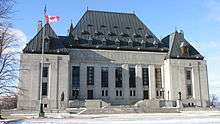 Supreme Court of Canada Building in Ottawa, Ontario Canada
Supreme Court of Canada Building in Ottawa, Ontario Canada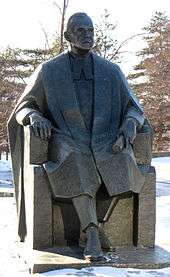 Prime Minister Louis St. Laurent statue (1976) by Erek Imredy in front of Supreme Court of Canada, Ottawa, Ontario Canada
Prime Minister Louis St. Laurent statue (1976) by Erek Imredy in front of Supreme Court of Canada, Ottawa, Ontario Canada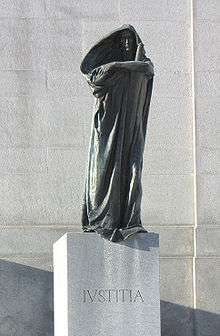 Walter Seymour Allward's Justitia (Justice), outside Supreme Court of Canada, Ottawa, Ontario Canada
Walter Seymour Allward's Justitia (Justice), outside Supreme Court of Canada, Ottawa, Ontario Canada
See also
- Supreme Court of Canada cases
References
- ↑ "Role of the Court". Supreme Court of Canada. 23 May 2014. Retrieved 2014-05-27.
- ↑ ""New judges fill gaps in spectrum"". The Globe and Mail. 5 October 2004. Retrieved 2016-05-06.
- ↑ " ""Two women named to Canada's supreme court"". UPI. 4 October 2004. Retrieved 2016-05-06.
- ↑ "Supreme Court loses third veteran judge in a year with Justice Marie Deschamps' departure". Toronto Star. 18 May 2012. Retrieved 2014-05-27.
- ↑ R. v. Beare; R. v. Higgins Archived 18 January 2012 at the Wayback Machine., [1988] 2 S.C.R. 387, para. 19.
- ↑ Consortium Developments (Clearwater) Ltd. v. Sarnia (City) Archived 18 January 2012 at the Wayback Machine., [1998] 3 S.C.R. 3, para. 1.
- ↑ Rothmans, Benson & Hedges Inc. v. Saskatchewan Archived 18 January 2012 at the Wayback Machine., 2005 SCC 13, [2005] 1 S.C.R. 188, para. 1.
- ↑ Whitbread v. Walley Archived 18 January 2012 at the Wayback Machine., [1990] 3 S.C.R. 1273, para. 2.
- ↑ Rothmans, Benson & Hedges Inc. v. Saskatchewan Archived 18 January 2012 at the Wayback Machine., 2005 SCC 13, [2005] 1 S.C.R. 188.
- ↑ Supreme Court of Canada - Frequently Asked Questions: "How Does One Address a Judge?"
- ↑ Provincial Court Judges’ Assn. of New Brunswick v. New Brunswick (Minister of Justice); Ontario Judges’ Assn. v. Ontario (Management Board); Bodner v. Alberta; Conférence des juges du Québec v. Quebec (Attorney General); Minc v. Quebec (Attorney General) Archived 19 January 2012 at the Wayback Machine., [2005] 2 S.C.R. 286, 2005 SCC 44, para. 21.
- ↑ "Judges Act". Minister and Attorney General of Canada. 9 June 2014. Retrieved 23 June 2014.
- ↑ Supreme Court Act, s. 6.
- ↑ Justin Trudeau (August 2, 2016). "Why Canada has a new way to choose Supreme Court judges". The Globe and Mail. Retrieved April 24, 2017.
- ↑ "New process for judicial appointments to the Supreme Court of Canada" (Press release). Government of Canada. August 2, 2016.
- ↑ "Prime Minister announces appointment of the Honourable Sheilah L. Martin to the Supreme Court of Canada" (Press release). PMO. December 18, 2017.
- ↑ "Prime Minister names the Honourable Richard Wagner as new Chief Justice of Canada". pm.gc.ca (Press release). PMO. December 12, 2017. Retrieved December 12, 2017.
- ↑ The Supreme Court of Canada / La Cour Suprême du Canada. Ottawa: Supreme Court of Canada. 2005. p. 7.
- ↑ The Supreme Court of Canada / La Cour Suprême du Canada. Ottawa: Supreme Court of Canada. 2005. p. 26.
- ↑ http://www.scc-csc.ca/empl/lc-aj-eng.aspx
- ↑ "1940 – Supreme Court of Canada, Ottawa, Ontario". archiseek.com. Retrieved 2014-05-27.
- 1 2 3 "Supreme Court of Canada, Ottawa" (Press release). Canada Post. 9 June 2011. Retrieved 2014-05-27.
- ↑ Cook, Marcia (11 May 2000). "Cultural consequence". Ottawa Citizen. Canwest. Archived from the original on 30 May 2010. Retrieved 11 October 2009.
- ↑ "Archived copy" (PDF). Archived from the original (PDF) on 20 March 2014. Retrieved 26 February 2015.
- ↑ Kathryn Blaze Carlson (11 May 2011). "Liberals take their leave of the Railway Room". National Post.
Further reading
- McCormick, Peter (2000), Supreme at last: the evolution of the Supreme Court of Canada, J. Lorimer, ISBN 1-55028-693-5
- Ostberg, Cynthia L (2007), Attitudinal decision making in the Supreme Court of Canada, UBC Press, ISBN 978-0-7748-1312-9
- Songer, Donald R (2008), The transformation of the Supreme Court of Canada: an empirical examination, University of Toronto Press, ISBN 978-0-8020-9689-0
External links
| Wikimedia Commons has media related to Supreme Court of Canada. |
- Supreme Court of Canada website
- Supreme Court of Canada Library Catalogue
- Opinions of the Supreme Court of Canada
- searchable database of SCC decisions (to 1948, with select older cases) via CanLII
- Supreme Court of Canada from www.marianopolis.edu
- Explore the Virtual Charter—Charter of Rights website with video, audio and the Charter in more than twenty languages
- The appointment process and reform
- SCC building from official site
- SCC Building
Coordinates: 45°25′19″N 75°42′20″W / 45.42195°N 75.705682°W
